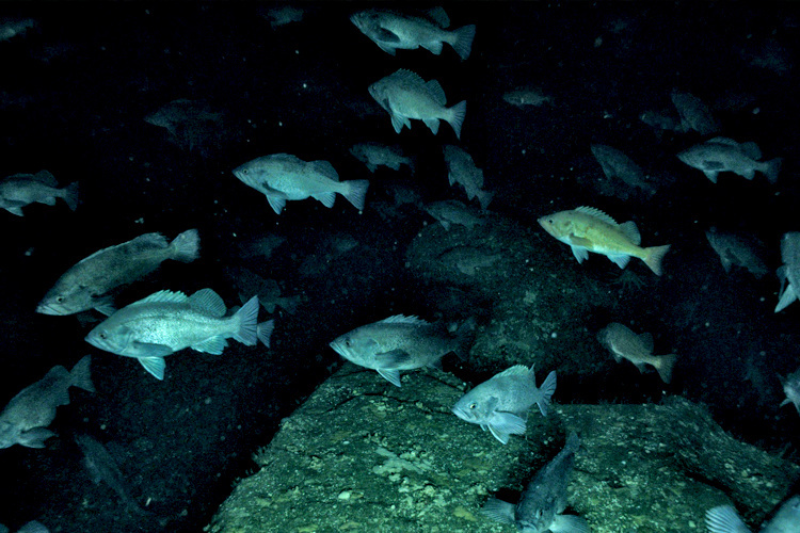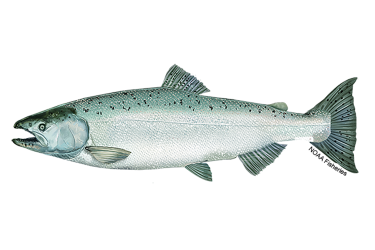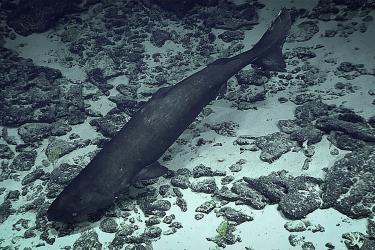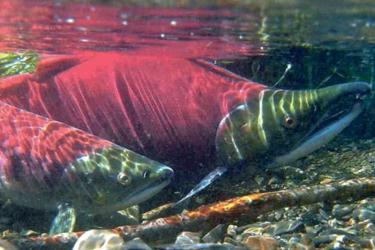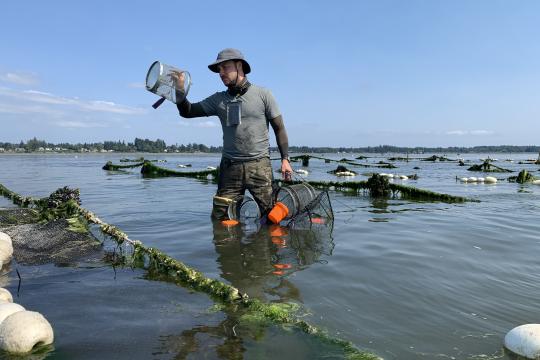When Gulf of Alaska rockfish Fisherman Bob Hezel approached NOAA Fisheries biologist Mark Zimmermann with an innovative proposal, he saw a potential solution to a rocky problem.
“Captain Hezel offered to collect scientific data in ‘untrawlable’ areas where standard NOAA Fisheries survey trawls can’t sample fish populations. I was impressed with the advanced technology that ships like his, the F/V U.S. Intrepid, use to fish in these rocky, steep habitats, like a live-feed video camera that helps them target their catch while minimizing gear and habitat damage,” Zimmermann said. “I was also impressed that Bob and Fishermen’s Finest wanted to use these capabilities to improve rockfish assessments. This fishery is really important to them, and they want to invest in the resource by providing us scientific data to manage it. They want to help ensure that annual catch limits are sustainable.”
That conversation spawned a cooperative pilot study to explore the possibility of using industry catch and effort data to inform Gulf of Alaska rockfish assessments. The new project is called the Science-Industry Rockfish Research Collaboration in Alaska.
“Rockfish fishermen are taking a long-term stake in conservation,” said John Gauvin, science projects director at Alaska Seafood Cooperative (offshore harvest cooperative). “The industry has made large investments to improve fishing practices. We hope some of those innovative fishing practices will provide data for this cooperative effort to improve rockfish stock assessments in the Gulf of Alaska. We expect this will take a strong partnership between industry and scientists, and we are fully on board with that. We are ready to make the necessary investment in time and resources to make it successful.”
"Accurate stock assessments are essential for setting sustainable harvest levels,” said Julie Bonney, executive director of Alaska Groundfish Data Bank in Kodiak, the manager of the six onshore rockfish harvest cooperatives. “NOAA Fisheries scientists partnering with experienced Gulf of Alaska rockfish skippers who are familiar with the fishing grounds and are using state-of-the-art, innovative fishing technology to access untrawlable grounds makes so much sense to help improve stock assessments."
“We have managers, academics, and fishermen working together. We are coming from many sides, using multiple perspectives to address this issue,” said co-investigator Madison Hall, NOAA Fisheries affiliate. “This is collaborative and innovative research to improve our data for rockfish management."
Managing a Valuable and Vulnerable Resource
The Gulf of Alaska rockfish fishery supports jobs and provides high-quality seafood for people in the United States and abroad.
More than 30 species of rockfish live in the Gulf of Alaska. Rockfish grow slowly, mature late in life, and produce few offspring. Their affinity for rocky habitats and this reproductive strategy makes them difficult to survey and vulnerable to overfishing.
The challenge lies in how to effectively survey in rocky areas while protecting habitat. The industry’s advanced camera systems can help because they enable fishermen to more safely navigate through these areas while avoiding damage to gear and surrounding habitat.
Careful management based on high-quality scientific information is key to keeping Alaska rockfish fisheries sustainable. Accurate stock assessments are essential to inform resource management.
“Despite their vulnerability to overfishing, the rockfish species we are focusing on are all listed as ‘best choices’ by Monterey Bay Aquarium Seafood Watch. The Gulf of Alaska trawl fisheries targeting these species are also certified as sustainable by the Marine Stewardship Council,” said Hall. “I think this project shows proactive innovation to collect essential data before species show evidence of overexploitation. This shows real foresight and demonstrates a commitment to sustainability by both managers and industry.”
NOAA’s FishWatch program calls all U.S. wild-caught Pacific rockfish species “smart seafood choices'' because they are sustainably managed and responsibly harvested under U.S. regulations. Each rockfish species is also listed as above target population levels on the Pacific Coast.
Untrawlable Habitat: Rockfish Got Their Name for a Reason
Rockfish live near the seafloor, often in rocky areas or around sponges and corals. This affinity for structure can make rockfish populations challenging to assess.
The Alaska Fisheries Science Center bottom trawl survey has historically been the primary tool to collect data for Gulf of Alaska rockfish assessment. The assessment is a formal method for setting fishing quotas, a process that gets reviewed through the North Pacific Fishery Management Council.
“NOAA Fisheries has a long history of conducting bottom trawl surveys in the Gulf of Alaska on chartered industry vessels, but the survey gear is not designed to sample in the steep, rocky habitats preferred by many rockfish species. Owing to a combination of advanced technologies and specialized trawl gear, the commercial fishing fleet can fish in some of these habitats,” co-investigator Brad Harris of Alaska Pacific University explained. “Including industry-derived data for these areas helps complete the picture."
These rocky, rough, areas that are inaccessible to the survey trawl (untrawlable) make up as much as 18 percent of the Gulf of Alaska seafloor. However, the percentage of rockfish distribution found in these areas and the extent to which the fishery accesses these areas remain unknown.
“Rockfish can be found in both trawlable and untrawlable habitat, but only trawlable habitats can be sampled by bottom trawl survey gear. To improve our understanding of rockfish distribution and abundance, which is necessary information to provide accurate stock assessments, we need to sample in untrawlable habitats,” said NOAA Fisheries biologist and co-investigator Pete Hulson. “Fishermen have gear that catch rockfish in those areas. They also use advanced technology like underwater video and acoustics to navigate their nets through these rough, rocky areas. In concert with cooperative catch and effort data, this technology could provide valuable information for rockfish stock assessments.”
“We recognize that the tools used by NOAA Fisheries surveys are not sampling a large portion of the rockfish habitat,” said NOAA Fisheries biologist and co-investigator Stan Kotwicki. “We see this cooperative effort as a potential way to complement our own survey effort to provide better quality data for rockfish stock management.”
Developing a Collaborative Rockfish Survey
Official surveys operate by making many tows in the same way across many randomly selected sites. It can be difficult to incorporate fishery-dependent data into stock assessments because no two tows are the same; industry gear can differ from boat to boat and site selection is not random. The Science-Industry Rockfish Research Collaboration plans to use new stock assessment methods that allow for the incorporation of fishery-dependent data from untrawlable habitats. These methods require cooperation and careful study of gear performance and fishing behavior to minimize the differences between tows.
“The main idea is that the fishery is already performing all this effort in habitats the survey cannot reach, but not in a standardized way. We need to collect data in a way that is both useful for assessment and practical for fishermen. We hope to do this by making minor modifications to existing industry effort,” Hall said.
“We are modeling our effort after a recent successful collaboration between the Alaska Department of Fish and Game and the golden king crab fishery in the Aleutian Islands. But we are realizing it is very different because of the different gear.” Zimmermann said. “Before we can apply this model to the rockfish trawl fleet we need to answer some questions. Exactly what data would be most useful? What kind of procedures do we need to establish to collect these data?”
To answer these questions, the team developed a two-part plan.
“First we need to see if historical fishing industry data can be used to create an index of rockfish abundance. We need to understand whether the trends in abundance from industry catch and effort data align with NOAA Fisheries bottom trawl survey abundance estimates,” said Hall.
That involves statistical analyses of industry data, meetings with fishermen, and going out on fishing trips to see industry in action.
The second part of the plan is to explore the degree to which industry tows can be standardized in the future to assess abundance.
“We want to see what is possible. We will talk with fishermen to see what is logistically feasible for them,” said Hall.
Once the team has explored the historical data and future options, they will develop an industry survey design. Finally, they will launch a pilot survey.
“After the study we will have the tools and knowledge to establish a cooperative program with industry to provide fishing industry data that can be incorporated into Gulf of Alaska rockfish stock assessments. We believe that will result in better management, ensuring maximum economic benefit while continuing to minimize the risk of overfishing,” Zimmermann said. “We see this work as precedent-setting. If this model is successful, we hope we can apply it to other trawl fisheries.”
This project is a collaborative effort between NOAA Fisheries’ Alaska Fisheries Science Center (Mark Zimmermann, Madison Hall, Pete Hulson, Stan Kotwicki, Jim Thorson); Alaska Pacific University (Brad Harris, Madison Hall, Curry Cunningham, Suresh Sethi); Alaska Seafood Cooperative (John Gauvin); and the Alaska Groundfish Data Bank (Julie Bonney).
This research is being performed while Madison Hall holds a National Research Council Research Associateship award at the National Oceanic and Atmospheric Administration.
